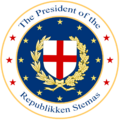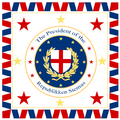President of the Republic of Stemas
| President of the Republic of Stemas | |
|---|---|
 Seal of the President of the Republic of Stemas | |
 | |
| Style | Your Excellency |
| Residence | Presidential Palace, Bakne, Republic of Stemas |
| Appointer | People of the Republic of Stemas |
| Term length | 5 Years, Renewable three times |
| Constituting instrument | Constitution of the Republic of Stemas |
| Precursor | King of the Kingdom of Stemas |
| Formation | May 1860 |
| First holder | Carol Olsen |
The President of the Republic of Stemas is the popular elected Head of State of Stemas every five years through free and secret ballets every Presidential Election Cycle. The President of Stemas is the Commander in Chief of the Armed Forces of Stemas, the Head Executive, and the Highest Executive Authority in the Republic of Stemas according to the Constitution of the Republic of Stemas.
History
The Office of the President of the Republic of Stemas was created in 1860 when the Country of Stemas asked for the King to resign his power and authority over Stemas and to allow the People to create a Government for the People. In May of 1860 the Republic of Stemas was created by the previous Parliament under the Monarchy and the President of the Parliament at that time became the First President of the Republic of Stemas.
Since the creation of the Republic the office of President has gone through many changes to where it is today, by some the President is regarded to almost equal in power to the former Monarchy of Stemas. The President is one of the oldest Office of Democratic Principles in former Ahranaian Crown Lands since the Independence of the other Independent Lands.
Election
The President is Elected by the People of Stemas in what's called the Presidential Election Cycle that happens every five years per the Constitution. A person can be President for five years and be re-elected three time in total before the highest Executive Office is no longer obtainable by an individual. When voting for the President the election method used is first past the post method, meaning the first candidate to pass the required votes needed to win that province will gain all the votes in that province. Since the adoption of this method the Conservative Party has held the Highest Office of the land for over ten decades since first coming into office in 1921.
Powers
The Republic of Stemas is a Semi-Presidential system. The President of the Republic is one of the more Powerful Presidents in Eurth compared so some Presidents of foreign governments. Although the Prime Minister of the Republic, through their Government as well as Parliament, oversee much of the nation's actual day-to-day domestic affairs, wields significant influence and authority, especially in the fields of national security and foreign policy. The president's greatest power is the ability to choose the prime minister. However the Stortinget has the sole power to dismiss the prime minister's government, the president is forced to name a prime minister who can command the support of a majority in the assembly.
- When a majority of the Stortinget has opposite political views to that of the president, this leads to political cohabitation. In that case, the President's power is diminished, since much of the de facto power relies on a supportive prime minister and Stortinget, and is not directly attributed to the post of president.
- When the majority of the Stortinget sides with them, the president can take a more active role and may further influence government policy. The prime minister is then a more personal choice of the president, and can be easily replaced if the administration becomes unpopular.
The President has the power to:
- The president promulgates laws.
- The president has a suspensive veto:
- When presented with a law, they can request another reading of it by Stortinget, but only once per law.
- The president may also refer the law for review to the Constitutional Council prior to promulgation.
- The president may dissolve the Stortinget.
- The president may refer treaties or certain types of laws to popular referendum, within certain conditions (among them the agreement of the prime minister or the Stortinget).
- The president is the chief of the Armed Forces.
- The president may order the use of nuclear weapons.
- The president names the prime minister. In theory, he cannot directly dismiss him, but at least a few recent PM's are known to have given an undated letter of resignation for themselves to the president upon taking office, and the president generally has some influence over the PM. The president also names and dismisses the other ministers, with the advice of the prime minister.
- The president names most officials (with the assent of the cabinet).
- The president names certain members of the Constitutional Council. (Former presidents are also members of this council)
- The president receives foreign ambassadors.
- The president may grant a pardon (but not an amnesty) to convicted criminals; the president can also lessen or suppress criminal sentences. This was of crucial importance when Stemas still operated the death penalty: criminals sentenced to death would generally request that the president commute their sentence to life imprisonment.
Criminality and Impeachment
The President of the Republic can only be removed from office by the Forbundsrådet if the President has done the following:
- Violated the Constitution
- Been convicted of Felony and withheld this information or any information regarding their Criminal History
- Is not a Citizen of the Republic and falsified records to cover this information
- Failure to Discharge their Power and Authority of the Office they hold
- Abuse of Power of the Office they hold
The President, if removed from office, is then and can be trialed by the Constitutional Court of the Republic of Stemas for any of the offenses for their removal from office or any other offenses the Prosecution Office finds the President is responsible for. If the Constitutional Courts finds the former President guilty of any charges the person loses the title of President or Former President, Government Pension, and the ability to run for Public Office again within the Realm of the Republic of Stemas. The person can also face jail time depending on the charges of criminality per the Criminal Code of the Republic.
Presidential Succession and Incapacitation
If the Office of the President becomes vacant by assassination, resignation, or the President is unable to carry out the duties of President for a limited time then the Speaker of the Forbundsrådet of the Stortinget will hold the office till either the President can resume duties, or an Emergency Election can be held. Since the creation of the Office of President the Succession and Incapacitation Clause of the Constitution has only happened six times with two assassinations, one attempted assassination, and three Incapacitation Power Transfers with the longest transfer lasting 30 days. Since there is no Vice President to succeed the President upon Assassinations of any death, the Interim President who is the Speaker of the Forbundsrådet will call for elections within 30 days upon their taking of the Office of President and no later than that.
Death in Office
If the President dies of natural causes in Office similar to the Assassinations of the President, the Speaker of the Forbundsrådet will become the Interim President for no more than 30 days from the entrance into the Office as President. The former president who died in office will be given a State Funeral paid by the Government and buried in the National Cemetery of the Republic in the Capital unless otherwise directed.
